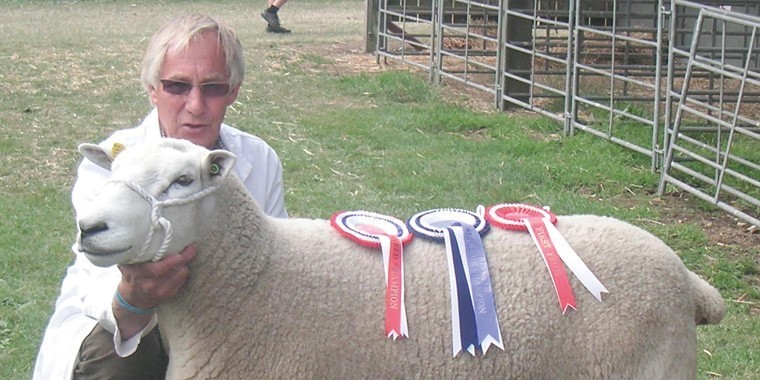For the majority of flocks, tupping is either completed or on the final cycle. That is it, the deed is done and the size of next year’s lamb crop is largely determined.
Each year, as it has been for centuries, rams are joined with the ewes more in hope than expectation, that next crop of lambs will be a good one, but life is rather more “interesting” and is often inclined to present us with a few little surprises.
In all probability, the impact of this year’s uncommonly hot summer and early autumn will be carried over into next year’s lamb crop due to adverse effects, potentially on both ewe and ram performance. For the ewes the effect may already have been obvious with a significant number of ewes going to the ram at a lower body condition score (BCS) having failed to regain sufficient condition after weaning to reach optimum BCS. I consider that I was lucky in having some grazing in front of the ewes all summer, often a little better than standing hay, but with the support of molasses blocks a little top up feed for a few plainer (old) ewes they generally did quite well and joined the tups at about target condition.
Some of the tegs were a little too fit, having been on some heavier ground that maintained some green grass on it all summer. I understand that others were not quite so lucky and really struggled to get condition back onto ewes, resulting in some ewes going to the ram in sub-optimal body condition, the potential impact of which will not be seen until scanning or lambing next spring.
Some rams have also struggled with maintaining BCS over the summer, although generally this should not have been a problem if rams were properly managed in the eight to 10 weeks running up to tupping. Proper ram preparation should have addressed any health, nutritional and BCS issues long before rams joined the ewes. Potentially the most significant issue with rams is one that could not easily be identified, that is the possible impact of the hot weather on reducing ram fertility, with our normal summers this is not a significant issue, particularly when rams have access to adequate shade; this year however, with shade temperatures exceeding 30°C on some days carrying through into September, it may be a somewhat different scenario.
Temperatures for most would have been rather more amenable when the tups joined the ewes, but sperm production in rams is a long process, from the time that the sperms are first formed until they have matured enough to be viable, takes approximately seven weeks. As a result it is not the weather at or immediately prior to tupping that is critical, we need to review the previous 1.5 to two months and consider what was happening during spermatogenesis, only then can we make a reasonable assessment of the possible impact on ram fertility.
With a smallish pedigree Lleyn flock, I normally expect 85%+ of my ewes to produce a good set of twins. As a result, I do not, for the most part, consider scanning my ewes to be beneficial, particularly with lambing outside. One does have to consider practicalities and separating a few singles and a few triplets into separate paddocks for differential feeding is generally not worth the inconvenience.
In addition, past records and trial results indicate that, for my ewes, there is no significant benefit, particularly with feeding molasses blocks as part of their ration pre-lambing in different feeding regimes for singles, twins and triplets. I am very much of the view that there is no point in gathering information that is not going to be used, I have endured rather too much of that in recent years, particularly if it is going to cost to collect that information.
However, this season I am seriously considering scanning, it does seem to be that preliminary scanning results emerging from a number of the earlier lambing flocks are showing a greater frequency of singles than would be expected in a normal season. A situation that is certainly worth monitoring and acted upon if required. The fact that cost of supplementary feed is going to be appreciably higher this year certainly adds greater weight to the argument in favour of scanning.
Sheep breeding is an uncertain process, most of what we do is a highly variable biological process, with inherent variability related, among other things, to ewe and ram health, nutrition, age and, probably the most interesting and infuriating, genetics, all undertaken at the mercy of the weather.
Many a new breeder, particularly those with a fat wallet, ego to match and little experience, thinks that by buying champion ewes and rams they will breed champions, whereas good sheep are more likely to produce good lambs, this is by no means guaranteed and many end up disillusioned. Genetics is a funny thing, it is possible for a ram to click with a group of ewes one year and produce a super crop of lambs, but the same combination the next season may produce a bunch of mongrels, a situation that the novice breeder often fails to understand.
A normal sheep cell has a compliment of 54 chromosomes. Ova and sperm have only half that at 27, but during the process of cell division that gives rise to these germ cells, there are two occasions when chromosome are randomly shuffled. The net result is that, even with the same ram and ewes, the chances of producing lambs that are genetically identical in a subsequent lambing are a little in excess of 134 million to one, odds only marginally less than for a jackpot win on the Euro Lottery and three times greater than for the National Lottery. Life is full of little surprises, that’s sheep!
Very best wishes to everyone, for Christmas and the New Year.




